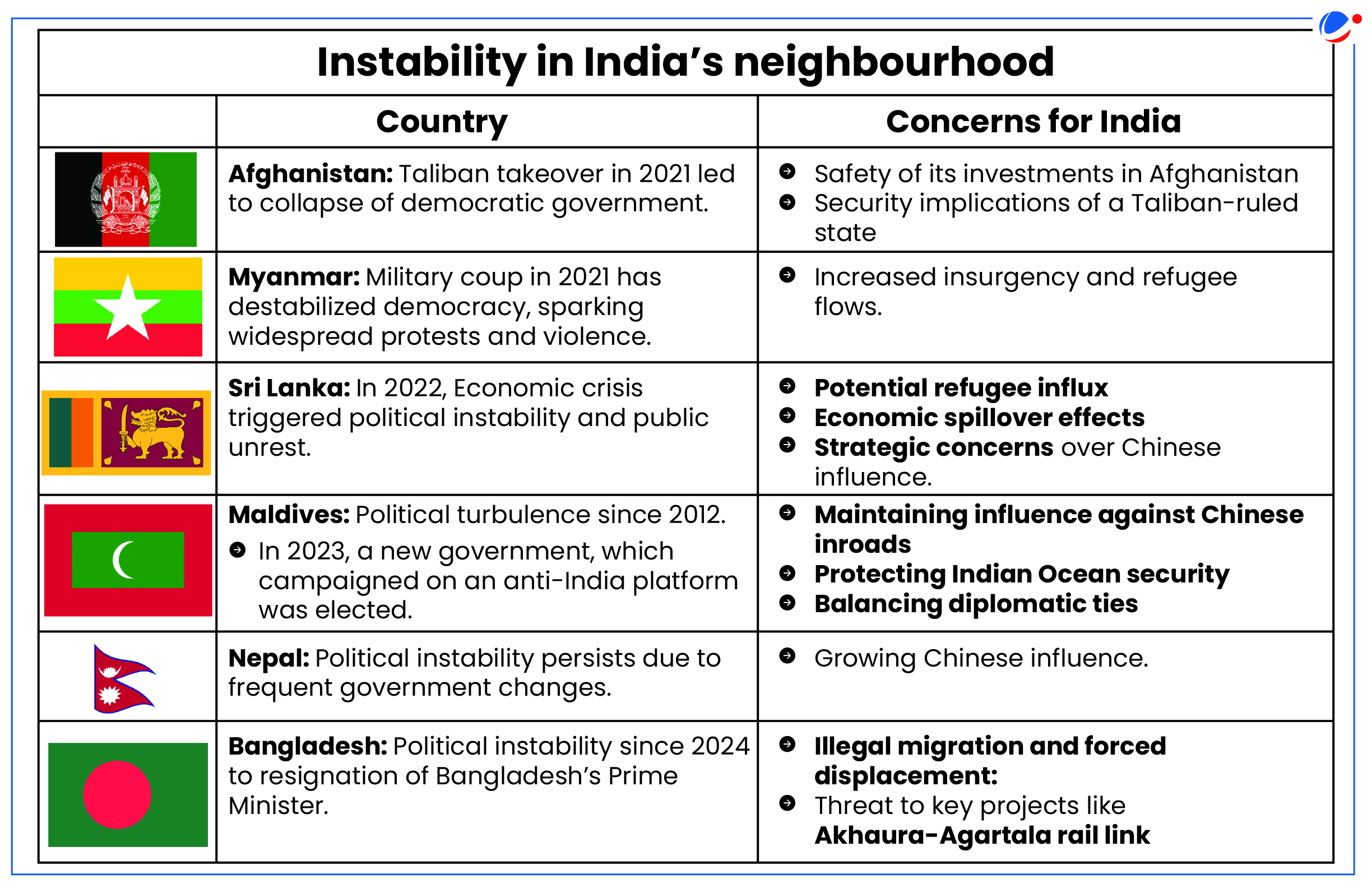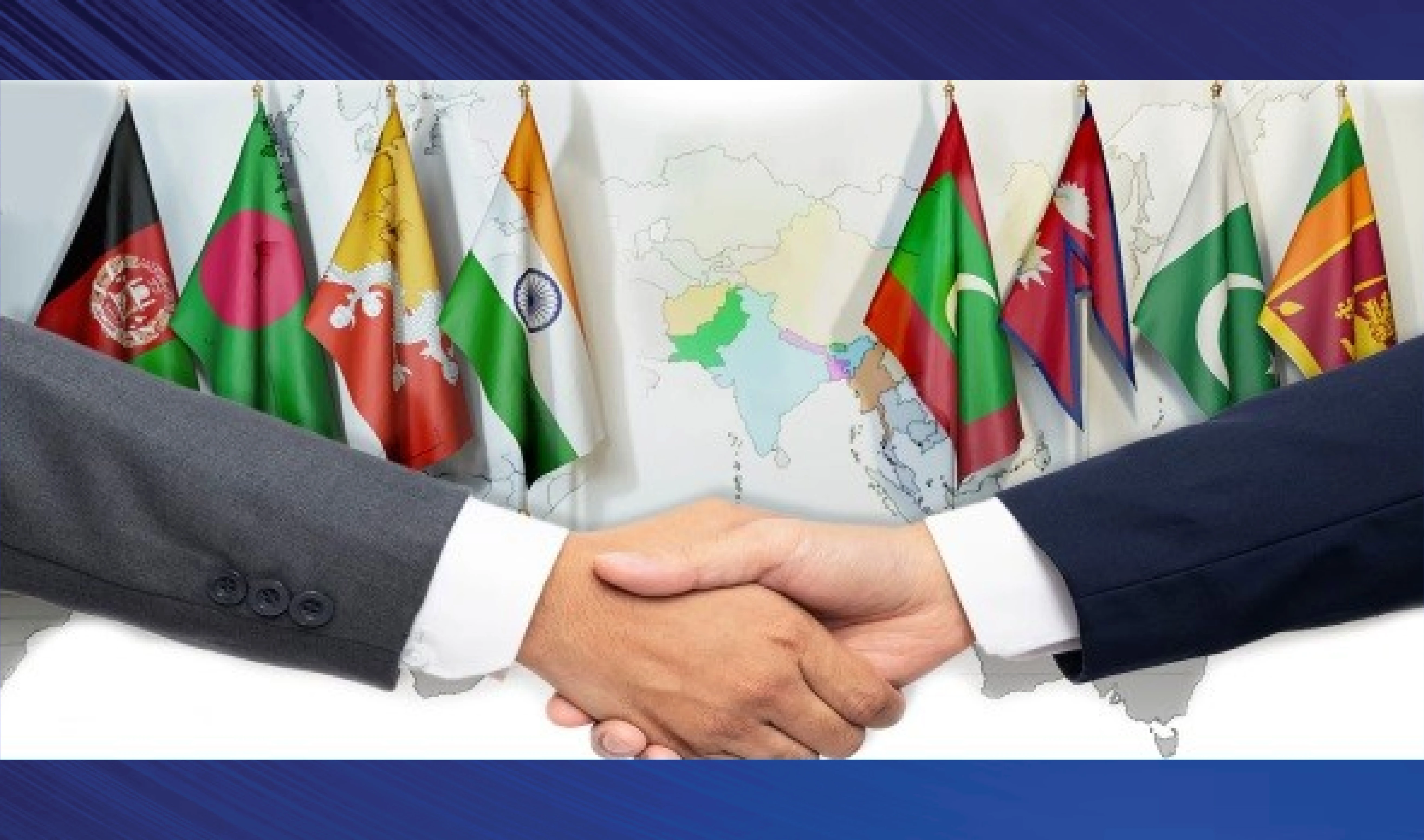Why in the News?
India's Neighbourhood First policy has completed a decade.
About India's Neighbourhood First Policy (NFP)
- Genesis: The NFP was conceived in 2008, with its focus intensifying post-2014.
- Concept: India's 'NFP guides its approach towards the management of relations with countries in its immediate neighbourhood.
- Countries part of NFP: Afghanistan, Bangladesh, Bhutan, Maldives, Myanmar, Nepal, Pakistan and Sri Lanka.
- Aim: To enhance physical, digital and people to people connectivity across the region, as well as augmenting trade and commerce.
- Key principles of engagement: 5S- Samman (respect), Samvad (dialogue), Shanti (peace), Samriddhi (prosperity) and Sanskriti (culture) guided by Consultative and Non-Reciprocal, Outcome-Oriented and Holistic Approach.

Key aspects of India's NFP
- Enhanced Economic Cooperation through Connectivity: Aims to create interdependencies that strengthen India's influence and counter external powers.
- E.g., Bangladesh: Mongla seaport rights and rail transit in July 2024 reduce costs for northeastern India.
- Increased High-Level Political Engagements: Build trust and strengthen diplomatic ties, ensuring a stable regional environment.
- E.g., Nepal: Prime Minister of India's 2014 visit, first in 17 years.
- E.g., Afghanistan: Zaranj-Delaram Road, Pul-e-Khumri to Kabul Transmission Line, Salma Dam Power Project, Afghan Parliament Construction.
- Development Assistance and Infrastructure Projects: Aid is critical during crises and for long-term development, consequently, positioning India as a reliable partner.
- E.g., Maldives: Greater Malé Connectivity Project bridge, Hanimadhoo Airport, etc.
- Energy Cooperation and Regional Power Markets: Develop regional energy markets and enhance energy security through hydropower and power trade agreements.
- E.g., Bangladesh: Tripartite Power Trade in 2024 enables importing 40 MW from Nepal via India.
- Geopolitical Balancing and Countering External Influence: The policy provides opportunities to counter China's influence and maintain South Asia as India's sphere of influence.
- E.g., Maldives: Steady financial support to Maldives, particularly currency swaps, is a direct counter to China's influence.
- Humanitarian and Disaster Relief Engagement: India has consistently responded as the first responder.
- E.g., Vaccine Maitri: Maldives and Bhutan becoming the first recipients, in line with "Neighbourhood First" policy.
- E.g., Sri Lanka: India's US$4 billion financing during the 2022 economic crisis.

Challenges Faced by India in its Neighbourhood
- Internal instability: Recent political upheavals and instability in neighbouring countries have significant implications for regional stability and India's strategic interests in the neighbourhood. (see infographic)

- Perceived Interventionism: Negative perceptions of India as an interventionist power (perceived 'Big-Brother' attitude), consequently, worsening relations.
- E.g., India's 2015 economic blockade in Nepal, seen as protecting Madhesi interests, heightened anti-India sentiment.
- Slow Project Implementation: Delays in infrastructure projects erode confidence and fuel anti-India sentiment.
- E.g., The Greater Malé Connectivity Project in Maldives faced protracted timelines, becoming a political issue.
- Unresolved Disputes and Irritants: Failure to resolve key issues like water sharing, taxes, and fishing, causing ongoing friction.
- E.g., Teesta River water sharing with Bangladesh, illegal fishing in Sri Lankan waters, and the Kalapani dispute with Nepal remain unresolved.
- Lack of Coordination Within India: Internal policy inconsistencies affect trade and transit, exacerbating tensions.
- E.g., The Suvidha fee implemented by West Bengal increased costs for boulder exports from Bhutan to Bangladesh via India.
- China's Growing Influence: Despite India's efforts, China's increasing presence in South Asia, notably in Sri Lanka (e.g., Hambantota Port), Nepal & Bangladesh (part of BRI), and Maldives, continues to challenge India's regional dominance.
Way forward
- Diplomatic Engagement and Sensitivity: India needs to engage diplomatically with its neighbors while being sensitive to their political realities and domestic issues.
- Given that most of these nations are democratic, the pressures of electoral cycles and competitive politics also have to be managed.
- Addressing Critical Irritants: India must resolve long-standing issues, such as water-sharing disputes (e.g., the Teesta River issue) and territorial disputes (e.g., Kalapani and Kachatheevu).
- Balancing Economic Assistance: While offering economic support, India should avoid fostering over-dependence. Projects should be implemented efficiently to enhance India's image as a reliable partner.
- Geopolitical Prudence: By managing China's growing influence in the region while ensuring that neighboring countries do not feel pressured into choosing sides.
- Encouraging Democratic Values: India must support democratic processes while addressing concerns regarding political instability, as seen in Bangladesh, the Maldives, Afghanistan & Myanmar.
- Adapting to Domestic Political Shifts: India should remain flexible in its approach to diplomatic relationships, especially in countries like the Maldives and Sri Lanka, where domestic politics often shift.
Conclusion
India's Neighbourhood First policy, guided by Samman (respect), Samvad (dialogue), Shanti (peace), and Samriddhi (prosperity), contrasts with China's neo-imperialistic, debt-trap diplomacy, fostering cooperative, sustainable, and mutually beneficial regional relations.




